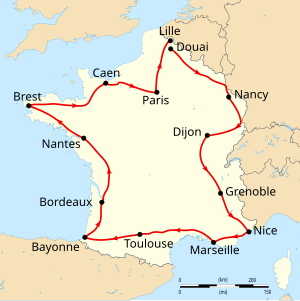1906 Tour de France

Route of the 1906 Tour de France
Followed clockwise, starting in Paris |
||||||||||
| Race details | ||||||||||
|---|---|---|---|---|---|---|---|---|---|---|
| Dates | 4–29 July | |||||||||
| Stages | 13 | |||||||||
| Distance | 4,637 km (2,881 mi) | |||||||||
| Winning time | 31 points | |||||||||
| Results | ||||||||||
|
||||||||||
| Winner |
|
|
| Second |
|
|
| Third |
|
The 1906 Tour de France was the fourth of the edition Tour de France, and second to use the point system. Taking place from 4 to 29 July the total race distance was 4,637 kilometres (2,881 mi) run over 13 stages, with the winner averaging 24.463 kilometres per hour (15.201 mph). New in this year were the mountain climbs in the Massif Central. Like its predecessors, it still had cheating and sabotage taking place. Four competitors were disqualified for taking trains as a shortcut and spectators threw nails in the road. However, this did not stop René Pottier from taking a big lead in the first stages. Free of tendinitis that plagued his 1905 chances, he dominated the entire race.
Tour organiser Henri Desgrange had been happy with the increased length of the 1905 Tour de France, and decided to put even more stages in the 1906 version. The introduction of mountain stages had also been successful, so this year not only the Vosges were included, but also the Massif Central.
The increased length made it possible to follow the borders of France, and in 1906 the perimeter was closely followed.
The points system in the 1905 Tour de France had been successful enough in reducing cheating, so the Tour organisers used it again in the 1906 Tour de France, with a few changes: whereas in 1905, time differences still had some effect on the points distribution, in 1906 time differences were unimportant, and points were only given for the order in which the cyclists finished. The winner of the stage received one point, the second rider two points, et cetera. After the eighth stage, only 16 cyclists were remaining, and the results from the first eight stages were recalculated, with only the remaining cyclists, and the points were redistributed among the remaining riders in accordance with their positions in those stages.
The first stage ended in Lille and the second stage started in Douai; this was the first time that a stage did not start where the previous stage ended. Also for the first time, the Tour went outside France: in the second stage, Germany (Alsace-Lorraine was then part of Germany) was visited. The 1906 Tour also saw the introduction of the flamme rouge (red flame), a red flag that indicates that the cyclists only have one kilometre to go.
There were 100 cyclists signed up for the race, but only 76 of them came to the start. One of the absentees was Henri Cornet, winner of the 1904 Tour de France. Four cyclists were Belgian, one was Luxembourgian (later winner François Faber), one was German, and the rest were French.Louis Trousselier, winner of the 1905 Tour de France, was present. The riders were not grouped in teams, but some cyclists had the same sponsor, even though they were not allowed to work together. Before the race started, most was expected from Cadolle, Aucouturier, Georget, Pottier, Trousselier, Dortignac and Petit-Breton.
...
Wikipedia
